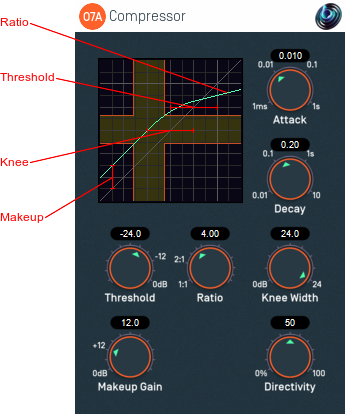O7A Compressor

Host Support
| Host Type | Support |
|---|---|
| AAX | Yes |
| VST2 | Yes |
Audio
| Channels | Content | |
|---|---|---|
| Input | 64 | O7A |
| Output | 64 | O7A |
Controls
Description
This plugin applies compression to an O7A stream. This has the effect of decreasing the dynamic range of the stream without substantially disrupting spatial placement.
The main difference between this and conventional compressors is its spatial processing. A directivity control allows the compression to be applied consistently over the entire sound scene, or independently in different directions; or somewhere in between.
The Graph
The graph at the top left of the panel shows the compressor response curve, plotting the input level along the horizontal axis and the output level along the vertical axis. Grid lines are shown at 6 decibel intervals.
The current ranges of input and output levels are also shown in real-time, in blue. These ignore the current attack and decay settings.
The plugin is available in the O7A Manipulators plugin library.
Controls
Control: Threshold
Assuming the knee width control is set to zero, the threshold is the level (in decibels) above which compression applies. Quieter signals are not affected.
When the knee is not set to zero, the transition through the threshold is not abrupt, but is instead smoothed out. The threshold then determines the centre of the transition interval.
The threshold can be seen in the graph provided as the point around which the slope of the response curve changes.
Control: Ratio
The ratio determines how much compression is applied to the signal when its level is above the threshold (and close to it when a soft knee is in use).
The ratio determines the inverse slope of the output level versus the input level, once above the threshold (and knee), when plotted in decibels. It can be seen in the graph provided as the slope of the response curve on the right hand side.
Control: Knee Width
When the knee width is set to zero, signals quieter than the threshold are not compressed and signals above the threshold are. This can be a fairly abrupt transition in some circumstances and is known as a "hard knee".
Setting the knee width to a non-zero values changes this behaviour, arranging for the output level to change smoothly over an interval. This is known as a "soft knee".
The knee width is measured in decibels and its centre is determined by the threshold. It can be seen in the graph provided as the interval over which the response curve transitions from one slope to another.
Control: Makeup Gain
This "makeup" gain amplifies the output of the compressor. It can be seen in the graph provided as an upwards shift in the response curve. It is typically used to make up for the reduction in level that results from compression.
Controls: Attack and Decay
The attack determines how quickly the effect responds to an increase in sound level by decreasing its gain and the decay determines how quickly the effect relaxes again when the sound level drops.
The values are defined as the time it takes the gain to move by 10 decibels.
Control: Directivity
Previous controls will be familiar to those who have worked with conventional compressors before. However, the O7A Compressor affects an entire sound scene.
A directivity value of zero means that sounds in all directions are compressed using the same gain. For instance, if a mix consists of a drum track and strings in different directions, a loud event in the drum track may result in the compressor kicking in, bringing down the entire mix level (including the strings). This can be thought of as equivalent to "Stereo Linking" in a conventional stereo compressor.
Increasing the directivity means that sounds in different directions are compressed more independently. In the example above, this means that the loud event in the drum track would affect the strings less.
- O7A A60->B Converter
- O7A B->A60 Converter
- O7A Compressor
- O7A Diffuser
- O7A Directional Emphasis
- O7A Directional Mask
- O7A Graphic Equalizer
- O7A Join
- O7A Line
- O7A Low/High Pass Filter
- O7A Move
- O7A Order Amplifier
- O7A Panner LS
- O7A Panner LS XYZ
- O7A Panner LS8
- O7A Parametric Equalizer
- O7A Portal
- O7A Reflection
- O7A Screen Resizer
- O7A Spatial Equalizer
- O7A Spatial Mask
- O7A Spatial Mask Split
- O7A Spotlight
- O7A Spotlight Split
- O7A Swap
- O7A Zoom
- O7A Zoom XYZ
